Victor Milán’s The Dinosaur Lords series is set in a primordial world with every species of dinosaur, large and small. The books are bloodsoaked—the basic elevator pitch is “Jurassic Park meets Game of Thrones”—specifically because the saurians aren’t around to be pets, attractions, or build a Dinotopia. Milán employs them as scaly war engines, which brings up a question pondered by generations of kids as they’ve assembled plastic dinosaur toys in their sandboxes—which are the best dinosaurs to wage war?
An enormous, excessively-fanged theropod would be the obvious choice. We’ve all daydreamed about clambering atop a Tyrannosaurus to vanquish our enemies. (Right?) But there are two problems with this plan. The first is that the carnivore might be just as likely to eat you as your enemy. A morsel is a morsel to a hungry carnivore. That, among other reasons, is probably why there haven’t been war tigers or battle wolves outside the annals of fantasy. And despite the psychological terror an armored, snarling tyrannosaur might inspire on the battlefield, it’d actually be terrible in an all-out fight. Tyrannosaurs, like all giant carnivorous dinosaurs, were bipeds. Break one of their legs, and they topple over useless and defeated.
Milán gets it. In his fantasy world, most of the war dinosaurs are herbivores that stomp around on all fours—crested hadrosaurs, horned dinosaurs, and the armored ankylosaurs. They seem like suitable stand-ins for dragons. Many had the spikes, horns, and crests to make them look intimidating enough. Despite their appearances, though, most of these dinosaurs wouldn’t have been as useful as you might expect.
Let’s start with the hadrosaurs. These dinosaurs, like the tube-crested Parasaurolophus and helmet-headed Corythosaurus, are famous for the low, booming calls they were able to make with their hollow headgear. But basic cable documentary speculations to the contrary, these calls wouldn’t have been in the range of sonic weaponry. The most that you could hope for was that a species evolved to deliver the legendary brown note and then equip your own side with earplugs. Given that the low-frequency calls of these dinosaurs could have carried long distances, though, they could be better put to use as signals to send warnings or messages from afar. Who needs the Horn of Gondor when you’ve got a Lambeosaurus?
Ankylosaurs would seem to be a better choice for war mounts. They’ve often been called “living tanks” for their extensive coats of bone armor, called osteoderms, from the spikes on their sides to the little pebbles of protection over their eyes. Euoplocephalus and some of the other famous species even had bony tail clubs that look perfect for battering attackers. The problem is that many of the spikes and other ornaments were probably for display more than defense, and those tail clubs came with some drawbacks. While the tail clubs of large species could have broken the bones of attackers, paleontologist Victoria Arbour has found, they also carried an increased risk of fracturing. Not to mention that it’s unclear whether these dinosaurs evolved these armaments to bludgeon vicious theropods or to smack each other during combat.
Many of the horned dinosaurs have the same limitations. The likes of Styracosaurus and Kosmoceratops had a lot of horns, yes, but these were probably more for showing off than fighting. Even if they managed to impale a soldier or other dinosaur, that victim would be stuck on the horn like a kebab. And with the exception of Triceratops, horned dinosaurs had huge holes in their frills. Even though the structures have been likened to shields, an expert marksman would be able to shoot right through the skin-covered gap and pierce the rider behind.
But there is one dinosaur that might work. Provided that the animal had a social dominance structure humans could co-opt, as we’ve done with horses when pressing them into war service, and was smart enough to be trained, Triceratops might be a formidable battlesaur. As I pointed out earlier in another post, Triceratops is one of the few dinosaurs whose bones provide evidence of prehistoric fights. They locked horns and shoved each other around. This would probably make them appealing for fantastical jousting competitions, at least, if not work on the battlefield.
Of course, battles aren’t only decided by hand-to-hand—or claw-to-jaw—combat. If we’re going to consider war dinosaurs, we can at least entertain the idea that small flying dinosaurs, like Microraptor, might be useful at ferrying messages through forests. Likewise, long-necked sauropods such as Brachiosaurus could be excellent lookouts, spotting friends or foes from far off. And small carnivorous dinosaurs like Sinosauropteryx could help keep camps clean by scavenging refuse. And these jobs are a better fit for the impressive saurians. Dinosaurs weren’t ravenous monsters, but real animals with vastly different modes of life. And if anything, we’re far more vicious than they could ever hope to be.
Buy the Book


The Dinosaur Lords Trilogy
All art by Richard Anderson.
This article was originally published in August 2015.
 Brian Switek is the author of My Beloved Brontosaurus (out in paperback from Scientific American/Farrar, Straus and Giroux) and Written in Stone. He also writes the National Geographic blog Laelaps.
Brian Switek is the author of My Beloved Brontosaurus (out in paperback from Scientific American/Farrar, Straus and Giroux) and Written in Stone. He also writes the National Geographic blog Laelaps.










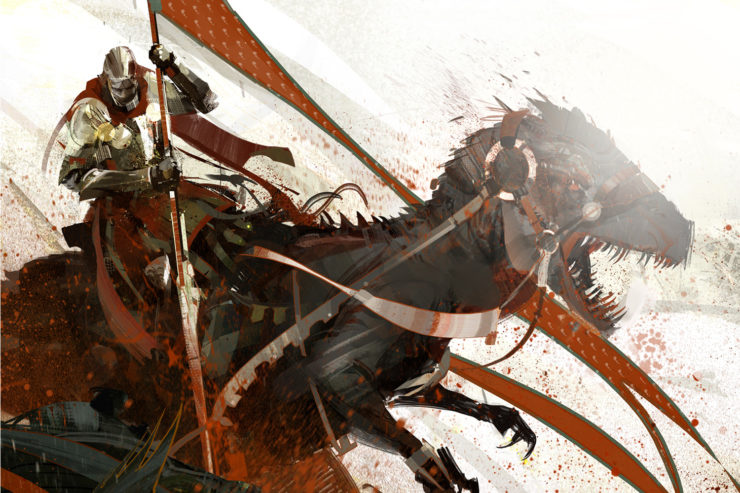
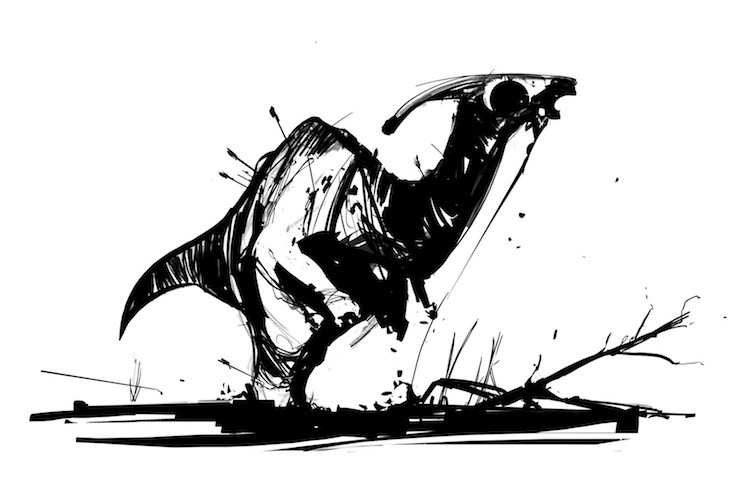
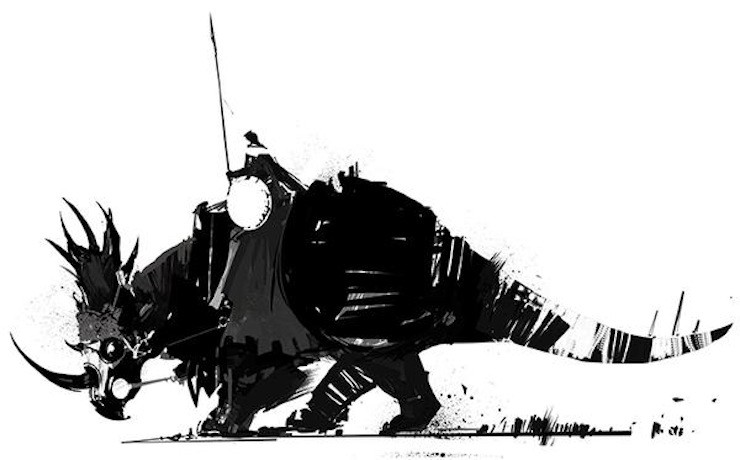
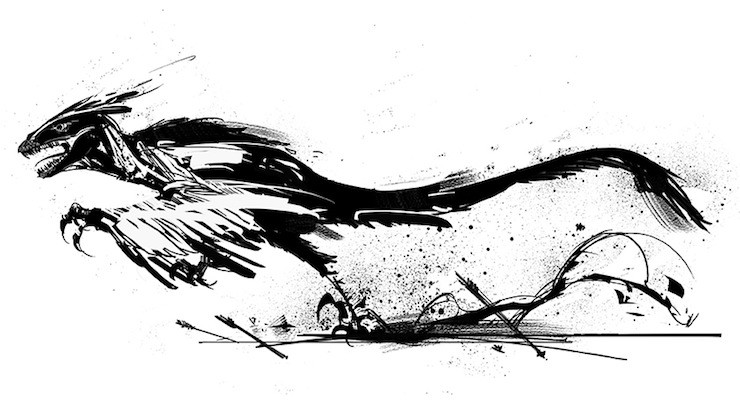
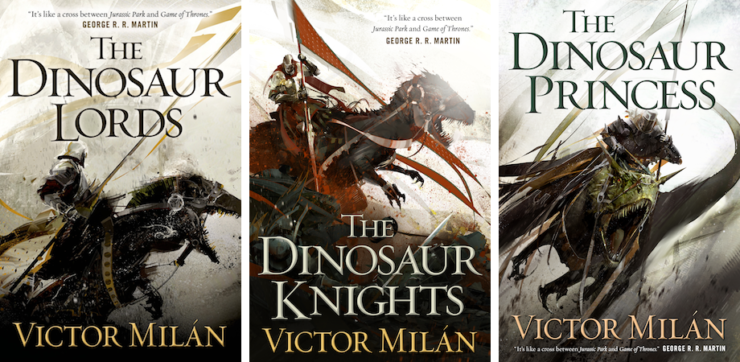
But what will dinosaurs be like after humans try a few centuries of selective breeding? Sure the wild stock of various types might not make good war beasts but if we turn a few of those ornamental features up to eleven they might be as dangerous as they look.
This is actually a cool idea
Manly Guys Doing Manly Things did a take on velociraptors bred for war.
Turns out they actually do make better pets.
http://thepunchlineismachismo.com/archives/comic/clearly-they-ride-minibikes-and-wear-tiny-tuxedos
http://thepunchlineismachismo.com/archives/comic/raptor-mom-comics
Daniel Jose Older has the Dactyl Hill Squad YA books. Dinosaurs and the Civil War.
Zombie tyrannosaurus on the other hand are extremely effective against other revenants, ghouls and necromancers
#5… Polka will never die…!
Since we now know that many of these (especially Velociraptor and Tyrannosaurus) were feathered beasts rather than “scaly war engines”, the coolness factor may have been somewhat reduced. Or perhaps enhanced, depending on your aesthetic.
The other obvious problem with carnivorous animals is feeding them. Very loosely, going by the ecosystem pyramid, you can have 10 horses or one tiger.
While big cats would be useless on a battlefield — to a tiger, people are just meat — there have been war dogs, which were effective weapons of the conquistadors